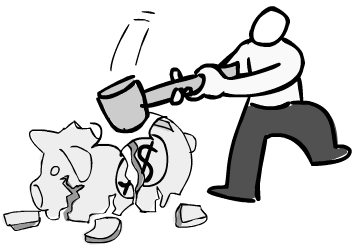 I got a lot of feedback from people after they read of my $17,902 meeting post. I spoke to a few others in my office and they all agreed that the number sounded plausible. As I'm writing my proposal for corrective action, I will deliver it in the form of a value proposition.
A value proposition is an analysis and quantified review of the benefits, costs and value that "something" an organization can deliver to customers and other constituent groups within and outside of the organization. It is also a positioning of value, where Value = Benefits / Cost (cost includes risk). (Thank you Wikipedia for basis of that definition)
I got a lot of feedback from people after they read of my $17,902 meeting post. I spoke to a few others in my office and they all agreed that the number sounded plausible. As I'm writing my proposal for corrective action, I will deliver it in the form of a value proposition.
A value proposition is an analysis and quantified review of the benefits, costs and value that "something" an organization can deliver to customers and other constituent groups within and outside of the organization. It is also a positioning of value, where Value = Benefits / Cost (cost includes risk). (Thank you Wikipedia for basis of that definition)
But, it's not as simple deliverable.
I use 7 stages of analysis.
- Customer or market - Who am I creating the value proposition for?
- Customer or market value - What do they say they value? (not what I say they value)
- Offering - What is the product or service being proposed?
- Benefits - What are the benefits? (Time, Money, Productivity,...)
- Alternatives - What substitutes or alternatives are there? (like doing nothing)
- Differentiation - How is my proposal different from anything else being offered?
- Proof - What evidence do I have that I can do what you say?
In this case, I'm going to request a formal review of the Communications Plan, modifying it if necessary. Because this is a status meeting (which is about reporting by one-way communication) not everyone needs to be there in person. Before I go deep into my analysis, I'm going to bet I can apply the Pareto principle (80-20 rule) to get my point across.
If we do not devalue the benefit of the meeting, we can increase the overall value by decreasing cost. That decreasing of cost, I would propose, would be asking 32 out of the 40 people to not attend the meeting in person. By having 8 key linchpins (as defined by Seth Godin) attend this meeting, we could ensure the status is delivered and the message is not lost.
Other indirect communication methods could be used to ensure the information is distributed. The slide deck and meeting minutes could be posted to a central location, allowing those who didn't attend the meeting in person to know what happened. Whatever the final outcome, there is a big opportunity for cost savings.
Graphic: Pictofigo







